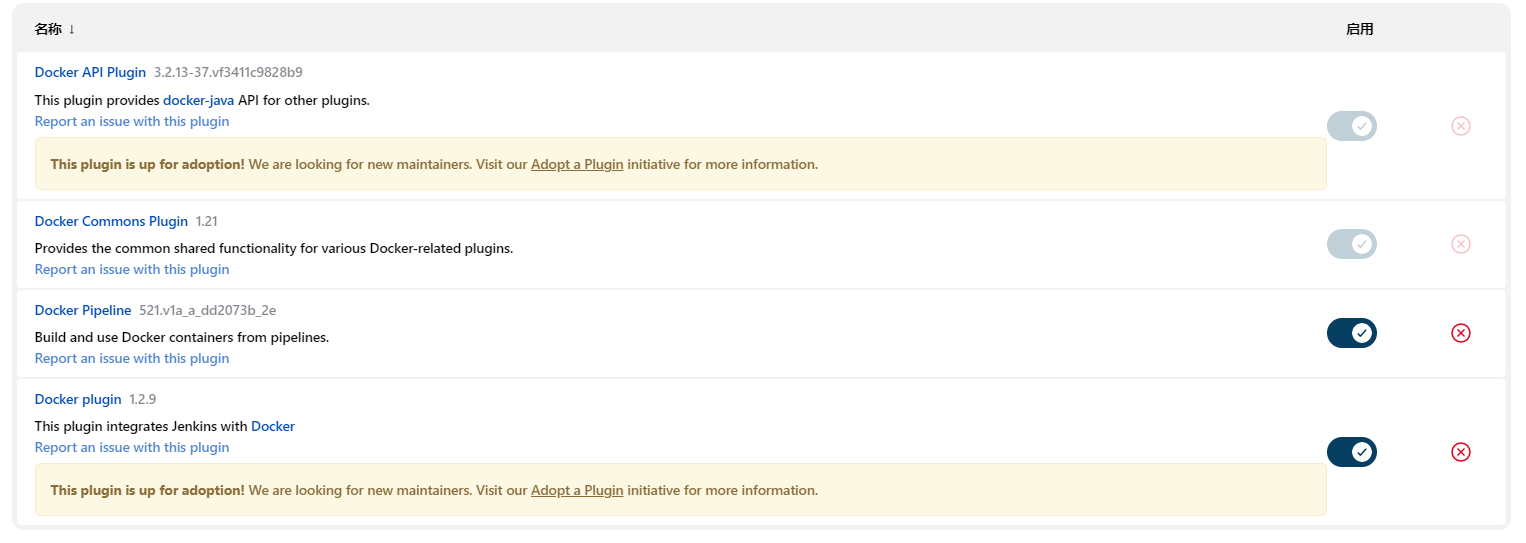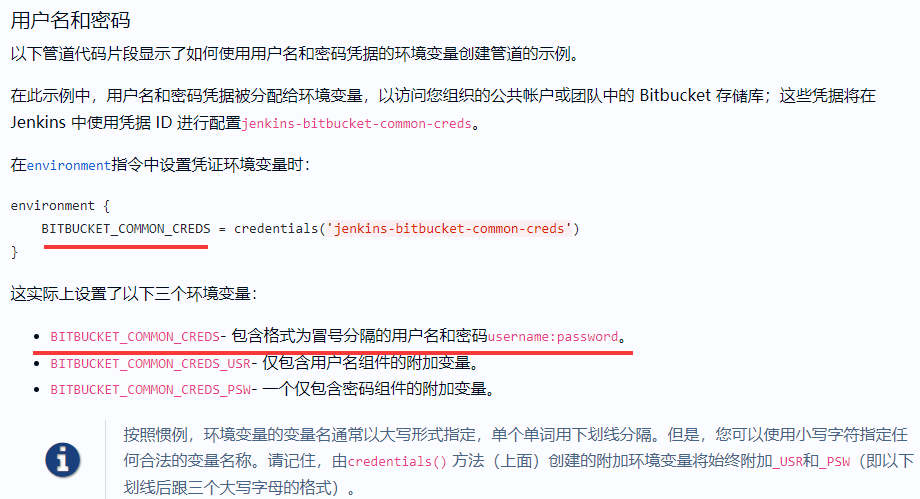Jenkins pipeline使用ssh凭据
环境信息
Linux环境
Linux version 3.10.0-1062.el7.x86_64 (mockbuild@kbuilder.bsys.centos.org) (gcc version 4.8.5 20150623 (Red Hat 4.8.5-36) (GCC) ) #1 SMP Wed Aug 7 18:08:02 UTC 2019
> cat /etc/redhat-release
CentOS Linux release 7.7.1908 (Core)
Jenkins版本

jenkins需要安装的docker插件

环境说明
CentOs7安装的Docker环境,使用Docker安装的Jenkins服务。
附录
[https://docs.docker.com/engine/install/centos/](Centos7 Docker安装指南)
[https://www.jenkins.io/doc/book/installing/docker/](Jenkins docker安装指南)
在Jenkins文件中使用凭据
先让我们了解以下credentials()方法都支持哪几种凭据呢?
支持以下三种凭据:
- secret text
- username and password
- secret file
https://www.jenkins.io/doc/book/pipeline/jenkinsfile/#handling-credentials
如果你使用的凭据正是以上三种之一,你就可以使用credentials()辅助方法。
否则你需要使用withCredentials(){}方法闭包进行使用凭据。
https://www.jenkins.io/doc/book/pipeline/jenkinsfile/#for-other-credential-types
这里就对配置和使用的方式不叙述了,因为参考的文档写的很详细了。
这里就对这2种使用ssh的注意事项吧。
credentials() 辅助方法
user and password方式
对环境变量的值的格式格外注意。

withCredentials(){}闭包
withCredentials(bindings: [sshUserPrivateKey(credentialsId: 'jenkins-ssh-key-for-abc', \
keyFileVariable: 'SSH_KEY_FOR_ABC', \
passphraseVariable: '', \
usernameVariable: '')]) {
// some block
// 请注意,这里对插值的说明没有问题,jenkins示例使用的是sh命令的方式,而这里是在groovy script脚本的方式。
// 在你的代码块里可以使用 "${SSH_KEY_FOR_ABC}"的方式进行引入变量的值,不过会在输出种有警告信息,脚本倒是能正常运行。
// 警告的信息就是说,凭据不能通过任何日志的形式输出出去。“在上面的 Groovy 中使用单引号而不是 双引号来定义script (隐含参数sh)。单引号将导致 shell 将密钥扩展为环境变量。双引号可能不太安全,因为密码是由 Groovy 插入的,因此典型的操作系统进程列表会意外地泄露它”
// 也可以使用 SSH_KEY_FOR_ABC 的方式进行引入变量的值,这种方式不会有警告信息。因为这是groovy语法,运行时脚本语言。
// 以下是代码示例。
// 示例1:会有警告信息
def keyfilepath = "${SSH_KEY_FOR_ABC}"
// 示例2:不会有警告信息
def keyfilepath = SSH_KEY_FOR_ABC
...下面就是使用ssh等语法了
}
[https://www.jenkins.io/doc/pipeline/steps/credentials-binding/#withcredentials-bind-credentials-to-variables](Jenkins withCredentials插件介绍)
示例pipeline脚本
pipeline {
agent {
node {
label 'agent-2'
}
}
stages {
stage('Example stage 1') {
steps {
sh "pwd"
sh "echo 'ni'hao你好a你好啊,wo'shi我是e'mo我是恶魔xian's'我是恶魔先生 > helloworld_test_jenkins.txt"
}
}
stage('print ssh primary key') {
steps {
sh 'printenv'
}
}
stage('Example stage 2') {
steps {
withCredentials([sshUserPrivateKey(credentialsId: '6581769e-f6cb-4501-a9b3-ceb51ca38fb8', keyFileVariable: 'primaryKeyVar', usernameVariable: 'userVar')]) {
script {
// some block
def remote = [:]
remote.name = '192.168.115.128'
remote.host = '192.168.115.128'
remote.user = userVar
remote.identityFile = $primaryKeyVar
remote.allowAnyHosts = true
stage('Remote SSH') {
sshPut remote: remote, from: 'helloworld_test_jenkins.txt', into: '/opt/'
}
}
}
}
}
}
}
常见问题
jenkins如何打印运行任务的环境变量信息?
steps {
sh 'printenv'
}
将以上脚本放到你将在哪个阶段(stage)打印环境变量信息里就行。
引用
https://plugins.jenkins.io/credentials-binding/
jenkins主服务器带的pipeline脚本生成器地址:http://jenkins主服务器地址/job/项目job名称/pipeline-syntax/,替换其中的描述字符即可。使用的方式参考https://www.jenkins.io/doc/book/pipeline/jenkinsfile/#handling-credentials的文档吧
20220920补充
1. 使用私钥最好使用rsa算法。
-
coding使用持续集成,编写jenkins文件,使用
remote.identity设置密钥字符串,最终结果是失败的,无效 invalid privatekey: [B@3a4328fa。

-
Jenkins使用pipeline流水线,编写jenkins文件,也是使用密钥字符串的形式,最终结果是失败的,无效 invalid privatekey: [B@3a4328fa。

最后使用rsa可以正常使用。
生成rsa密钥命令:ssh-keygen -m PEM -t rsa -b 4096




 浙公网安备 33010602011771号
浙公网安备 33010602011771号